
You may have looked at your yard and wondered “do I need a retaining wall?”. You may have seen your neighbors with retaining walls in their yards. Or perhaps your yard features a slope that might need erosion protection. Before you act, you should know what a retaining wall does, why it is necessary, and if you need one for your property.
What is a Retaining Wall?
As the name implies, this is a wall that holds or retains the soil in place that is along a slope. The most popular examples are retaining walls or terraces used by the ancient civilizations of South America high in the Andes mountain range. The retaining wall allows for the ground to be level and prevents it from sliding down the slope.
Why are Retaining Walls Necessary?
There are good reasons why you may need a retaining wall. The first as mentioned earlier is that it helps prevent the soil from sliding down the slope. As a form of erosion protection, a retaining wall can be quite effective and simple to maintain.
Another reason is that it controls the water runoff better which again helps keep the soil in place. A retaining wall can prevent soil from running into storm drains. In addition, it provides a level area to create a garden or a seating location for gatherings.
Do I Need One?
You may need a retaining wall under one or more of the following conditions:
- Foundation is threatened by sliding soil
- Too much downhill erosion
- Your property is below the soil fault line
Arguably the most important reason is that the soil sliding away from your home is threatening to compromise the foundation. A proper retaining wall can keep the soil in place, so your foundation stays strong.
If you are seeing a considerable amount of soil erosion, then you should get a retaining wall. This will minimize the erosion process and provide a level area for several types of features. Even if all you install is the retaining wall, it can help preserve the soil for a long time.

If your property is downhill from a soil fault line, then a retaining wall can provide greater stability in case of a major event such as a massive flood or earthquake. Homes that are placed on slopes and below the soil fault line are vulnerable to shifting if a major event breaks the soil away and causes it to move rapidly.
Retaining walls can be made of timber, brick, or stone. Before you decide on whether to get a retaining wall, consult with a soil expert to see if one is needed for your property. You may discover that a retaining wall is not the best solution. However, you may also find out that this type of wall offers additional benefits as well.
Answering the question “do I need a retaining wall?” begins with a proper evaluation of your yard. You may need to call in an expert to ensure that you make the right decision. Before you spend the money, be sure that a retaining wall is the right solution.
Contact Luxus Construction to get started. Please call 310-270-8596 for more information.

